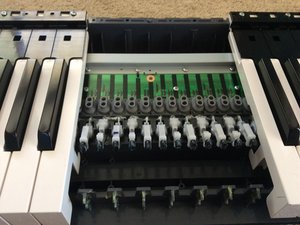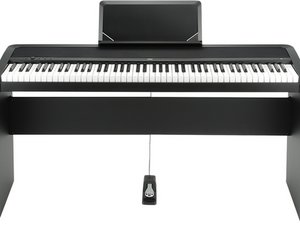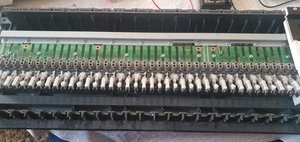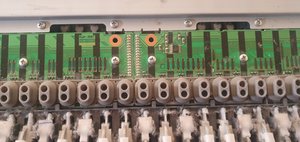Korg B1 - specific notes don't work, problem with circuitry
Aloha all, I just purchased a Korg B1 digital piano with known issues. The keyboard sounds great but has specific notes that don’t work. Starting from the E after middle C, all Es, Cs and G#s don’t work.
Luckily, I found another ifixit post, the only place on the internet it seems, where someone understood why specific notes wouldn’t be working. Here is the link: ++"E" key and 3rd black key is not working.
I understand very little about circuit boards, but I was able to identify the problem immediately. C, E and G# receive and give inputs along the same path. There is an issue with the soldering on one of the *things* at the first E key, where the problem starts. See the images for this issue.



So, one of my problems is that I don’t know anything about circuits or circuitry terminology, so I can’t even describe this issue, much less start to fix it.
Can anyone help me at least put a name to this, so I can start to go about fixing it? It seems like a basic circuitry issue that wouldn’t be hard to fix, but I don’t know where to start. Any help is appreciated.
Bu iyi bir soru mu?

 3
3  2
2 
 1,5b
1,5b 






4 Yorum
Not sure if @hakimj had resolved this fault?
Will C tarafından
@willcee
I don't know but @nathan_dixon_1993 had the same if not a similar problem and he solved it using the Chosen Solution.
See the post below the Chosen Solution
Click on the image to see how he bypassed the faulty track multiple with wiring between the keys.
jayeff tarafından
Hi, I can't seem to find a way to open the piano.
How do you disassemble the piano?
Ork Hossain Muntaqin tarafından
@hakimj I just bought a Korg B2N (used) and I have the exact same problem! All of the C’s, E’s and G#’s not working.
Were you able to fix the problem?? If so did you do it yourself ? I am useless at this type of stuff.
Please and thank you!
LaurelB tarafından